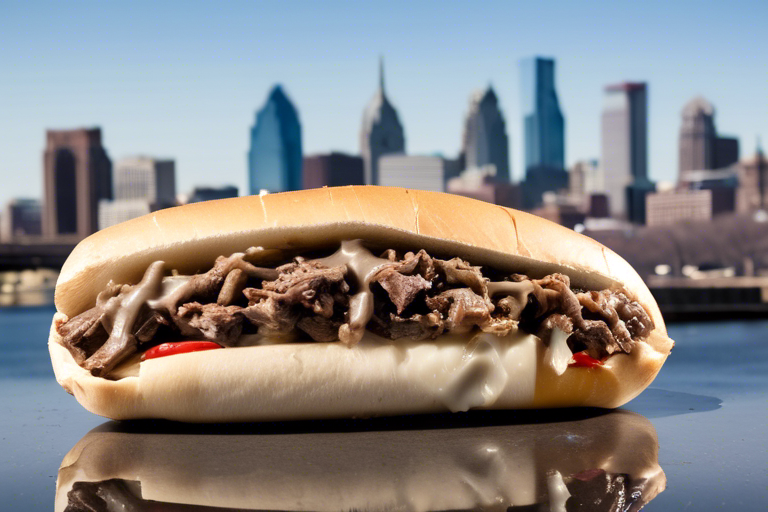The Philly Cheesesteak: The Culinary Identity of Philadelphia
The Philly cheesesteak is not just a sandwich; it’s a culinary legend born in the heart of South Philadelphia. The inception of this iconic dish dates back to the 1930s, crafted by Pat and Harry Olivieri, who initially operated a humble hot dog stand near the bustling Italian Market in Philadelphia. Originally, the cheesesteak emerged as a hearty meal made from thinly sliced beefsteak and melted cheese, elegantly tucked within a long hoagie roll, a recipe that has captivated the taste buds of many across Philadelphia, Pennsylvania.
This delightful fusion of hot beef and gooey cheese on a flaky roll quickly transcended its street food origins, becoming a beloved comfort food across Philadelphia. It sparked friendly rivalries between famed establishments like Pat’s King of Steaks and Geno’s Steaks since the 1960s. The journey from a simple steak sandwich to the renowned Philly cheesesteak signifies a delicious history worth exploring. This article aims to delve into the evolution of the cheesesteak, its signature variations, and its global reach, promising insights into why Philly cheesesteaks remain a pivotal element of culinary traditions.
The Birth of the Cheesesteak
The journey of the Philly cheesesteak from a simple grilled beef sandwich to the iconic dish it is today is a fascinating tale of innovation and community influence. Here’s how this beloved sandwich evolved:
- The Original Concept (1930): Pat Olivieri, a hot dog vendor, crafted the first iteration of what would become the Philly cheesesteak. Initially, it was just grilled beef and onions served on a toasted roll. This simple yet delicious combination quickly caught the attention of locals, including a cab driver who suggested Olivieri focus on selling these beef sandwiches instead of hot dogs.
- Introduction of Cheese (1940s): The cheesesteak as we know it today didn’t include cheese in its original form. The transformative addition of cheese to the sandwich was made by Joe “Cocky Joe” Lorenza, a manager at Olivieri’s Ridge Ave. location. This significant tweak introduced provolone cheese to the mix, marking the birth of the authentic Philly cheesesteak.
- Popularity and Expansion: The sandwich’s fame soared, leading to the establishment of iconic venues like Geno’s Steaks in the 1960s, located directly across the street from Pat’s. This period also saw the cheesesteak being made with alternative meats like horse meat during World War II due to shortages. However, the classic combination of steak, onions, and cheese remained a constant, solidifying the Philly cheesesteak’s status as a culinary staple in Philadelphia and beyond.
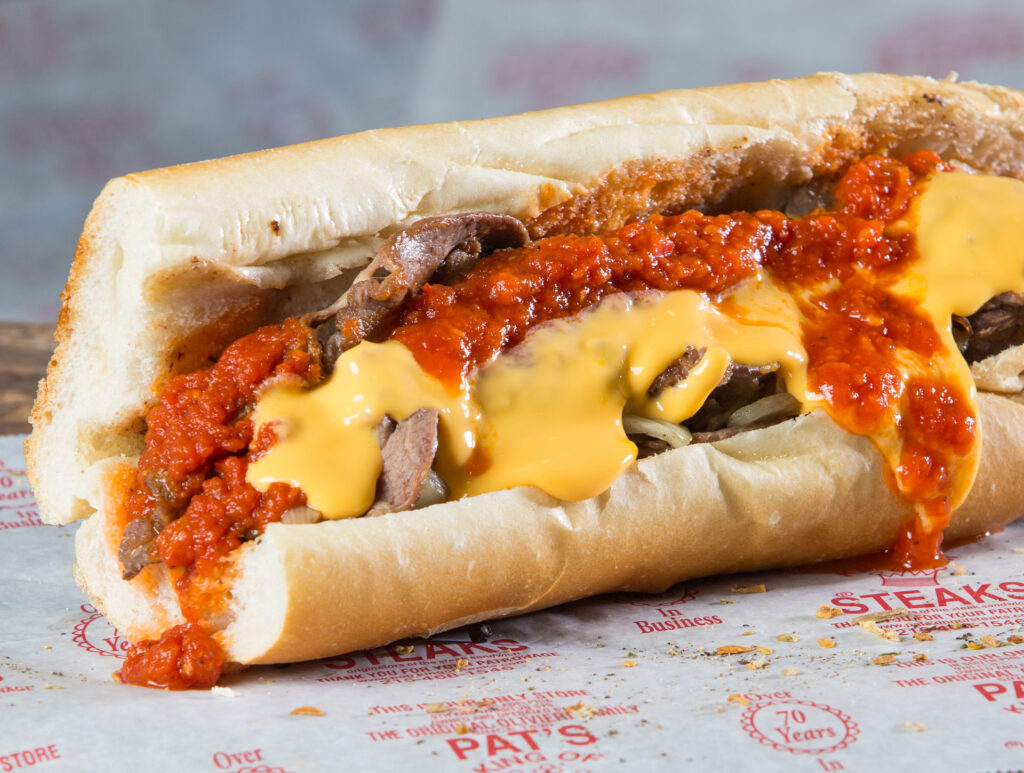
This evolution showcases not only the adaptability of the Philly cheesesteak but also its deep-rooted connection to the city’s history and culture.
From Steak Sandwich to Cheesesteak
Transitioning from a Steak Sandwich to a Cheesesteak:
The Name:
-
- Initially known as a “steak sandwich,” the iconic dish underwent a significant transformation with the addition of cheese in the 1940s. This pivotal addition not only enriched the flavor but also marked the beginning of a new era for the sandwich, leading to the adoption of the term “cheesesteak” to describe this evolving culinary delight.
- Introduction of Cheez Whiz:
- The 1950s witnessed another milestone in the cheesesteak’s journey with the introduction of Cheez Whiz. Its ease of use and unique ability to thoroughly saturate the roll made Cheez Whiz a popular choice among cheesesteak aficionados. This convenience and the distinct taste profile it offered further cemented the cheesesteak’s place in the hearts of Philadelphia’s residents and beyond.
By embracing these changes, the cheesesteak not only solidified its identity but also expanded its appeal, transitioning from a local favorite to a symbol of Philadelphia’s rich culinary heritage.
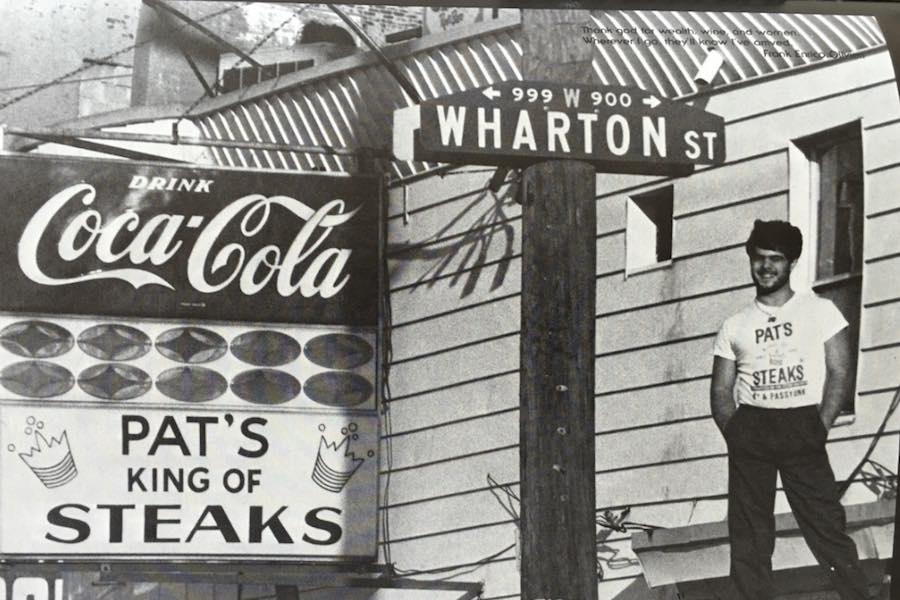
Signature Variations and Ingredients
The Philly cheesesteak’s versatility and adaptability have given rise to a plethora of variations, each with its unique twist on the classic recipe. Here, we explore some of the signature variations and ingredients that have contributed to the cheesesteak’s enduring popularity:
- Base Ingredients:
- Meat: The foundation of any Philly cheesesteak is its meat, traditionally thinly sliced rib-eye or top round, known for its rich flavor and tenderness .
- Cheese: The choice of cheese can significantly alter the cheesesteak’s taste profile. While American cheese, provolone, and Cheez Whiz are the most commonly used , newer options like Cooper Sharp are gaining popularity for their distinct taste .
- Bread: The sandwich is invariably served on hoagie rolls, with Amoroso rolls being a particular favorite for their crunchy exterior and soft interior .
- Popular Toppings and Variations:
- Toppings: Sautéed onions, grilled mushrooms, ketchup, hot sauce, salt, and black pepper are common additions that enhance the cheesesteak’s flavor .
- Variations: Beyond the traditional beef cheesesteak, variations include chicken cheesesteaks, mushroom cheesesteaks, pepper cheesesteaks, and pizza steaks . For those seeking plant-based options, a vegan cheesesteak made with seitan or mushrooms and soy-based cheese offers a delicious alternative .
- Innovative Creations:
- The culinary creativity doesn’t stop at the sandwich. Cheesesteak-inspired dishes such as Philly Cheesesteak Poutine, Cheesesteak Egg Rolls, Philly Cheesesteak Stuffed Peppers, and even Philly Cheesesteak Pizza showcase the recipe’s adaptability . These innovative takes on the classic cheesesteak allow for a broader appreciation of its flavors in various formats, catering to diverse tastes and dietary preferences .
This exploration into the signature variations and ingredients of the Philly cheesesteak not only highlights the sandwich’s adaptability but also its role in inspiring culinary innovation.
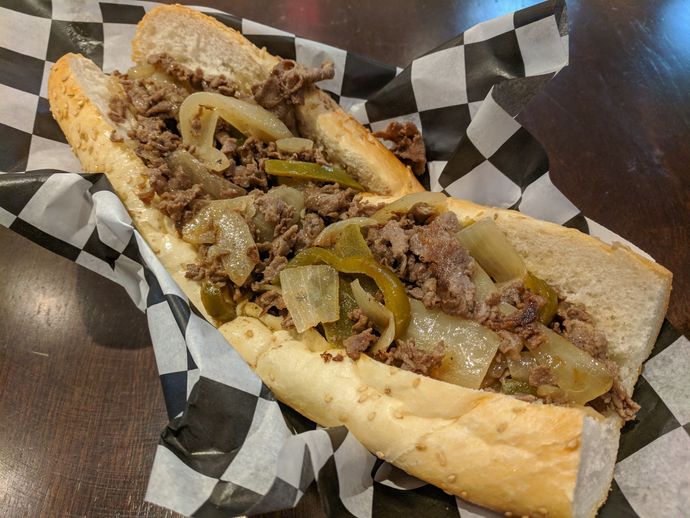
Iconic Cheesesteak Venues
Exploring the landscape of iconic cheesesteak venues reveals a diverse array of establishments, each contributing its unique flavor to the Philly cheesesteak legacy. From the traditional to the innovative, these venues are pivotal in understanding the cheesesteak’s evolution and enduring popularity.
- Traditional Titans: Pat’s and Geno’s
- Pat’s King of Steaks: Established in 1930, Pat’s stakes claim as the originator of the Philadlephia cheesesteak. Still owned and operated by the Olivieri family, Pat’s serves its cheesesteaks on Amoroso rolls, a key ingredient in delivering the authentic Philly experience. The friendly rivalry with Geno’s, located just across the street, adds to its allure .
- Geno’s Steaks: Founded in 1966, Geno’s is known for its thinly sliced rib-eye steak and vibrant neon lights. Despite criticisms for its crude version of the sandwich and political stances, Geno’s remains a staple in Philadelphia’s cheesesteak scene, contributing to the ongoing debate over who makes the best cheesesteak.
- Local Favorites and New Entrants
- Dalessandro’s Steaks and Chubby’s Steaks: Situated in Roxborough, these venues are beloved for their massive steaks. Dalessandro’s, with its finely chopped rib-eye and chunky onions since 1960, and Chubby’s, offering a finer chopped steak with a signature secret seasoning, showcase the local preference for hearty, flavorful cheesesteaks.
- Ishkabibble’s I & II: Known for their chunky steaks and unique offerings like Spanish fries and the original Gremlin, these shops on South Street highlight the versatility and creativity within the cheesesteak community, offering a twist on the traditional.
- Innovative and Diverse Options
- Woodrow’s Sandwich Shop: This South Street venue offers an upscale take with the Woodrow’s Whiz Wit, featuring shaved rib-eye, caramelized onions, and homemade cherry pepper mayo on a truffle-infused four-cheese Whiz. It represents the innovative spirit of Philly’s cheesesteak scene.
- Campo’s Philly Cheesesteaks: Located in Old City, Campo’s stands out for its commitment to inclusivity, offering vegan, vegetarian, dairy-free, and gluten-free options. This approach ensures that the Philly cheesesteak experience can be enjoyed by a wider audience, reflecting the evolving tastes and dietary preferences of the community.
Each venue, whether steeped in tradition or embracing innovation, plays a crucial role in the Philly cheesesteak narrative, offering a slice of Philadelphia’s culinary heart to locals and visitors alike.
The Cheesesteak Goes Global
The Philly cheesesteak’s journey from a local favorite to a global sensation is a testament to its universal appeal and adaptability. Here’s a glimpse into how this iconic sandwich has made its mark worldwide:
- Global Popularity:
- The cheesesteak’s presence is now a common sight in mall food courts, air force bases, and neighborhood grills not just in the United States but across the globe.
- With a staggering 72% of people worldwide expressing their liking for the Philly cheesesteak, it stands as the second most liked American dish out of 18 surveyed.
- Social discussions around the Philly cheesesteak have seen a 1% increase over the past year, indicating a growing interest in this culinary delight.
- Menu Presence & Consumer Preferences:
- Approximately 15.7% of restaurants feature the Philly cheesesteak on their menus, showcasing its widespread acceptance and popularity.
- The fastest rising consumer need identified for the Philly cheesesteak is as a ‘Snack’, suggesting a shift in how people are choosing to enjoy this dish.
- The most popular prepared food pairings with Philly cheesesteak include Sandwich (29.19%), Philly Cheesesteak (29.13%), Cheese Steak (29.13%), French Fries (3.01%), and Pizza (2.29%), highlighting its versatility.
- Trending food pairings have evolved to include BBQ Ribs, Hotpot, Yellow Rice, Taco Salad, and Croutons, reflecting changing tastes and preferences.
- International Adaptations and Innovations:
- In Lahore, Pakistan, the Philly cheesesteak thrives with various cafes like Philly’s Steak Sandwich, Café Zouk, Freddy’s, and CTC offering their takes on the classic sandwich.
- Egypt has embraced the Philly cheesesteak in unique forms, including bowls, pizzas, and man’oucheh, a Lebanese flatbread, showcasing the sandwich’s adaptability. Interestingly, in Egypt, the term “Philly” often refers to a type of cheese rather than the city, with Philadelphia cream cheese being a popular import.
- The global popularity of the Philly cheesesteak is largely attributed to America’s strong presence in international media, which has created a demand for American culture and regional specialties. This has led to mainstream adaptations such as Subway’s “Philly” sandwich, which includes a variety of toppings not traditionally found on cheesesteaks, demonstrating the sandwich’s influence and adaptability.
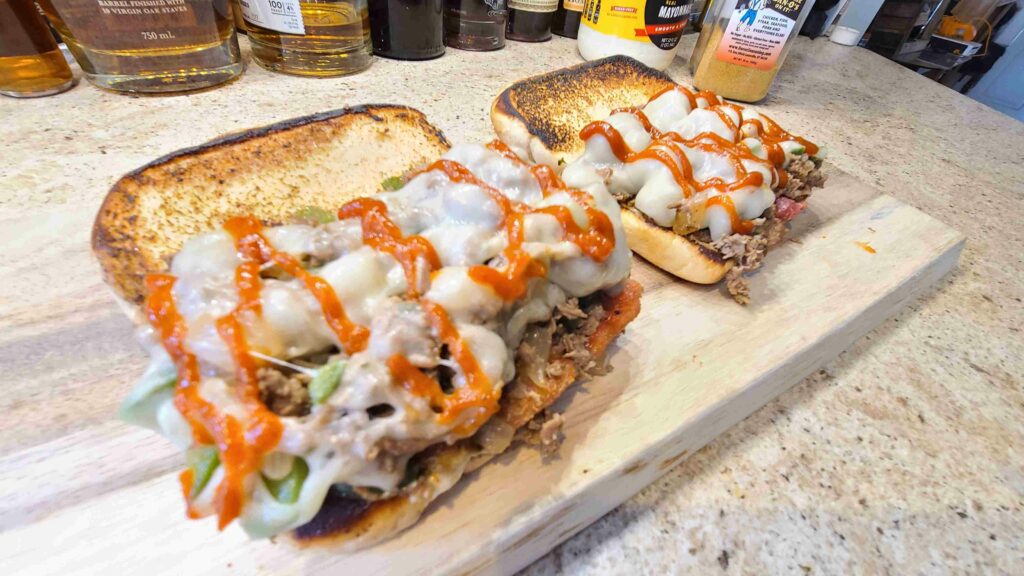
Through these insights, it’s clear that the Philadelphia cheesesteak has not only captured the hearts of Americans but has also found a place in the global culinary scene, adapting to local tastes while still retaining its core identity.
Cultural Impact and Controversies
The cultural impact and controversies surrounding the Philly cheesesteak illustrate its significance beyond a mere culinary delight, reflecting deeper societal and cultural undercurrents within Philadelphia and beyond:
- Cultural Symbolism:
- City Identity: The cheesesteak is more than just a sandwich in Philadelphia; it’s a symbol of the city’s identity and working-class roots, embodying the spirit of Philadelphians and their pride in local culinary traditions.
- Global Recognition: Recognized worldwide, the cheesesteak represents Philadelphia’s vibrant culture, attracting visitors from all corners of the globe eager to taste this iconic dish.
- Community and Pride: Beyond its taste, the cheesesteak signifies team spirit, local achievements, and a sense of belonging among Philadelphians, linking it to personal and collective identities within the city.
- Controversies and Debates:
- Pat’s vs. Geno’s Rivalry: The rivalry between Pat’s King of Steaks and Geno’s Steaks, fueled by media attention, has become a focal point of discussions about the best cheesesteak in town, reflecting broader debates on authenticity and culinary superiority.
- Political and Social Tensions: Geno’s Steaks has been at the center of controversy for practices such as displaying signs instructing customers to order in English and commemorating Daniel Faulkner, sparking debates on social and political issues within the community.
- Evolving Legacy: In response to past controversies, Geno Vento, son of Geno’s founder, has made efforts to distance the brand from divisive aspects of its legacy, focusing on the food and inclusivity.
- Representation and Evolution:
- Adaptability: The cheesesteak’s journey from a simple steak sandwich to a global phenomenon showcases its adaptability and the creativity of those who make it, with variations and imitations continuing to evolve.
- Symbol of Freedom: Interestingly, the cheesesteak has also been interpreted as a symbol of freedom, representing indulgent and hearty foods that defy conventional dietary norms, further adding to its cultural significance.
- Main Flavor Debate: Culinary preferences such as those expressed by BZ Maestro, who favors the meat as the main flavor with cheese in a supporting role, highlight the ongoing evolution and personalization of the cheesesteak experience.
Through its rich history, the Philly cheesesteak has become more than a meal; it’s a cultural icon intertwined with the identity, controversies, and evolving tastes of Philadelphia, reflecting the city’s past, present, and future.
The Great Cheesesteak Debate
In the heart of Philadelphia’s culinary scene, the debate over who serves the best Philly cheesesteak is a topic of passionate discussion among locals and visitors alike. Central to this debate are two iconic venues: Pat’s King of Steaks and Geno’s Steaks. Here’s a closer look at what sets these rivals apart and the broader cheesesteak preferences across the city:
- Pat’s vs. Geno’s: A Culinary Rivalry
- Steak Cut: One of the most noticeable differences between the two giants is in the preparation of the steak. Pat’s King of Steaks is known for its finely chopped steak, offering a texture that blends seamlessly with the melted cheese and onions. In contrast, Geno’s Steaks serves its steak in thin strips, providing a different mouthfeel and allowing the beef’s flavor to stand out more distinctly.
- Cheese Options: Both establishments serve their cheesesteaks with a choice of provolone, Cheez Whiz, or American cheese. This variety ensures that every patron can customize their sandwich to their liking, whether they prefer the creamy smoothness of Cheez Whiz, the sharp tang of provolone, or the classic taste of American cheese.
- With or Without Onions: Another customization option is the inclusion of fried onions, often referred to as “wit” for with onions or “without” for those preferring their sandwich onion-free. This choice adds another layer of flavor and texture to the already delicious combination of beef and cheese.
- Beyond Pat’s and Geno’s: Local Loyalties
- Despite the fame of Pat’s and Geno’s, many Philadelphians argue that the best cheesesteaks are found at smaller, local corner shops. These venues, often cherished parts of the community, are said to serve cheesesteaks that rival or even surpass those of the more famous establishments. The loyalty to these local shops is strong, with many residents believing that the best cheesesteak is the one from the shop they grew up with.
- The Classic Philly Cheesesteak Composition
- At its core, the Philly cheesesteak is a simple yet irresistible sandwich made with hot beef, melty cheese, and a long, flaky roll. Its straightforward composition belies the depth of flavor and satisfaction it offers, making it a beloved staple of Philadelphia’s culinary landscape.
This exploration into the great cheesesteak debate not only highlights the differences between two of Philadelphia’s most famous cheesesteak purveyors but also underscores the deep personal and communal ties many have with this iconic dish. Whether one prefers the chopped steak of Pat’s or the sliced approach of Geno’s, or even champions a local corner shop’s version, the Philly cheesesteak remains a delicious testament to the city’s rich culinary heritage.
Future of the Cheesesteak
The future of the Philly cheesesteak looks as vibrant and dynamic as its past, with evolving tastes and dietary preferences shaping its journey. Here’s what to expect:
- Expanding Definitions and Variations:
- New Fans: The ultimate comfort food continues to attract new admirers, broadening the definition of what constitutes a cheesesteak. Expect to see a variety of grilled meats, cheeses, toppings, and sauces as part of the cheesesteak evolution.
- Global Sensation: With a 1% increase in social conversations over the past year and a presence in 15.7% of restaurants, the Philly cheesesteak’s global popularity is undeniable. It’s not just a meal; it’s a culinary experience that transcends geographical boundaries .
- Innovative Dishes: From the Dutch Cottage Tavern in Pennsylvania to Puckett’s in Tennessee, restaurants are experimenting with unique cheesesteak dishes, expanding the traditional cheesesteak repertoire.
- Dietary Shifts and Health Consciousness:
- Vegan and Gluten-Free Options: As the demand for plant-based and gluten-free options grows, cheesesteak shops are adapting. This shift is not just a trend but a reflection of changing consumer preferences towards healthier lifestyles.
- Popular Pairings and Ingredients: The rise in soda, wings, fish, onion, and beer as the fastest-growing ingredients and flavors associated with cheesesteaks indicates a diversification in how people enjoy their cheesesteaks. From BBQ ribs to taco salad, the trending food pairings also suggest a more adventurous approach to cheesesteak consumption.
- Cultural Recognition and Food Tourism:
- A Symbol of Philadelphia: The cheesesteak’s role as a cultural icon continues to grow, with more tourists seeking authentic cheesesteak experiences. This interest has led to an increase in food tourism, including guided tours and behind-the-scenes looks at famous cheesesteak venues.
- Rivalry and Pride: The legendary rivalry between iconic shops like Pat’s and Geno’s is expected to persist, drawing locals and tourists alike into the great cheesesteak debate. This rivalry not only fuels interest but also fosters a sense of community and pride in Philadelphia’s culinary heritage.
As the Philly cheesesteak continues to evolve, it remains a testament to the city’s rich culinary tradition, adapting to new trends while staying true to its roots.
The journey of the Philly cheesesteak from a humble street food to a global culinary icon epitomizes the spirit of innovation and tradition that characterizes Philadelphia’s rich culinary heritage. Through the years, it has transcended its simple beginnings to become a symbol of the city, embracing new variations and expanding its reach far beyond its origins. The enduring popularity of the cheesesteak, underscored by passionate debates over its authenticity and best execution, reflects not just a love for food but also a deeper connection to Philadelphia’s identity and community pride.
As the Philly cheesesteak continues to adapt and thrive in the evolving landscape of dietary preferences and global tastes, its significance extends beyond a mere sandwich—it embodies the dynamism of culinary evolution and the collective memory of a city. The insights into the cheesesteak’s story, from its inception to its status as a meal cherished worldwide, underscore the rich tapestry of culinary innovation that keeps the tradition alive and well-loved. Looking ahead, the future of the Philadlephia cheesesteak seems assured, as it remains a crucial part of Philadelphia’s culinary legacy and a beloved item on the global food scene.
FAQs
What ingredients are included in a Jersey Mike’s Philly cheesesteak? Jersey Mike’s authentic Philly cheesesteak is made to order with succulent steak, sautéed peppers, caramelized onions, and melted white American cheese. This fan-favorite sandwich is known for its freshness and flavor.
Can you tell me about the origins of the Philly cheesesteak? The Philly cheesesteak was created by Pat and Harry Olivieri, brothers who operated a hot dog stand in South Philadelphia near the Italian Market. In the 1930s, they experimented with new offerings and came up with a sandwich featuring grilled beef and onions served on a toasted roll, which became the original cheesesteak.
What defines a traditional Philly cheesesteak? A traditional Philly cheesesteak is typically comprised of thinly sliced steak, melted cheese, and fried onions. It may also include additional toppings such as hot or sweet peppers and mushrooms. Variations like the pizza cheesesteak, which includes tomato sauce and mozzarella, also exist.
Is the Philly cheesesteak a tasty sandwich? Absolutely! A Philly cheesesteak is renowned for its delicious flavors. The ideal cheesesteak features a bread with a subtle yeasty taste, without the intensity of sourdough. The preferred meat is thinly sliced ribeye, prized for its tenderness, rich flavor, and juiciness. When seasoned with salt and pepper and cooked on a flat top grill, the ribeye’s taste is something many people enjoy.
